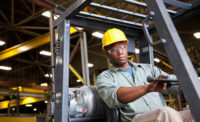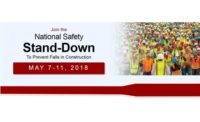A quick look at statistics reinforces that falls from heights account for a significant yearly number of disabling injuries and fatalities. The issue is so significant that for two years running, OSHA has promoted a National Stand-Down to Prevent Falls in the construction industry — covered by Part 1926 of the Code of Federal Regulations.
Fatalities caused by falls from elevation continue to be a leading cause of death for construction workers, accounting for 291 of the 828 construction fatalities recorded in 2013. Those deaths were preventable. Fall prevention safety standards were among the top 10 most frequently cited OSHA standards, during fiscal year 2014.” 1
But falls from heights and the need for fall protection not only affects construction workers. The same issue hits home for workers covered by OSHA’s 1910 General Industry rules — often within different types of work situations.
The history
OSHA currently provides rules that apply to general industry in regard to fall protection. Specifically, Subpart D: Walking-Working Surfaces is the current applicable rule concerning this topic.
At best, the standard can be called limited and outdated when closely examined. The standard does provide a general activation height of four feet where fall protection requirements begin, but measures of the 1970s-era rule are quite basic.
Per 1910.23(c) (1)(i-iii), “Every open-sided floor or platform four feet or more above adjacent floor or ground level shall be guarded by a standard railing (or the equivalent as specified in paragraph (e)(3) of this section) on all open sides except where there is entrance to a ramp, stairway, or fixed ladder. The railing shall be provided with a toe board wherever, beneath the open sides, [p]ersons can pass,[t]here is moving machinery, or [t]here is equipment with which falling materials could create a hazard.”
And that, briefly, is the entire rule for general industry employers to use to comply with the four-foot mandate: use guardrails.
Unlike its construction industry sister regulation where many fall protection options are offered for varied situations, 1910 continues to reflect the notion that all workers can be feasibly protected through guardrails alone. In reality, more flexibility is needed.
Where should employers turn for guidance concerning additional forms of fall protection?
Many employers might assume that they consult regulations in which other options have already been addressed, such as Subpart M from Part 1926. But unless indicated otherwise by OSHA, borrowing rules meant for another sector is not what OSHA directs employers to do. In fact, to deal with the acknowledged deficiency, OSHA has provided employers with options through other means available: directives, letters of interpretation and proposed rules.
PFAS for non-routine work
OSHA indicated in a 1984 Directive for General Industry that use of personal protective equipment for fall protection (the personal fall arrest system — PFAS) would be permitted for use on surfaces where workers were exposed to a fall hazard greater than four feet, in situations where work takes place on something other than a predictable and regular basis. This is defined as work done (1) at least once every two weeks; or (2) for a total of four man-hours or more during any sequential four-week period.2 PFAS use in these non-predictable / non-regular situations thus became permissible.
A new set of proposed rules
In 1990 OSHA issued a Proposed Rule to update Subparts D and its PPE rule, Subpart I, to provide more protection options to employers, including use within predictable and regular situations. This rule sat idle until 2003 when it was reopened for review. In 2005, the rule was determined to be out of date. It was redrafted due to fall arrest technology and fall prevention technique updates since its original release. The result: a May 2010 proposal that is under consideration today.
One of the goals of these new revisions is to harmonize more closely with Construction’s Subpart M. Instead of permitting PFAS use only under non-routine circumstances, the proposed rule offers employers options. Proposed Subpart D 1910.28(b) includes:
• Guardrails
• Designated areas
• Safety net systems
• Travel restraint systems
• Personal fall arrest systems
Amended Subpart I includes a section entitled Personal Fall Protection Systems, in which completely new PFAS requirements are held to “provide criteria on the proper use of personal fall protection systems when used by the employer.”3 Strikingly similar to text provided within 1926.502(d)/(e), it’s clear where many of the proposed additions have originated and it emphasizes OSHA’s desire to more closely harmonize standards set out in different industries for the same hazard type.
That said, the proposed rule is meant for general industry. It does not include some provisions applicable to construction environments. It lacks reference to protective setups such as controlled access zones and safety monitors, two very common systems employed by workers engaged in very specialized construction work. Also, as an updated rule it includes useful practices not even discussed within the construction industry standard, such as designated areas (known as warning lines in 1926, but only applicable to roofers doing “roofing work”), as well as travel restraint systems that keep workers from ever reaching a fall hazard in the first place. Both concepts are permissible via other avenues in the construction industry to most workers at heights.
The road ahead
On July 2, 2015, OSHA sent the proposed rule to the White House Office of Management and Budget (OMB) for final review, where it may be reviewed for 90 days. Originally, this timeframe meant that as of mid- to late October, general industry facilities would finally have a robust, promulgated fall protection rule. But delays at OMB have pushed the estimated release date back to April 2016, according to OSHA’s fall 2015 regulatory agenda.
No longer should general industry employers fall prey to looking toward Subpart M for guidance for fall protection solutions. A January 16, 1997 Letter of Interpretation stated: “The Subpart M fall protection requirements under 29 CFR 1926 Construction standards may not be used to meet the provision of fall protection equivalent to guardrails under paragraph1910.23(c)(1). The Occupational Safety and Health Administration intended that the Notices of Proposed Rulemaking on Walking and Working Surfaces and Personal Protective Equipment (Fall Protection Systems), which were published in Volume 55, Number 69 of the Federal Register (FR) on Tuesday, April 10, 1990 to be used.” 4
For reference, the general industry proposed rule can be found on OSHA’s web site. Search the A to Z Index at the top of the home page, select Fall Protection from the list and finally, click on Non-Construction Standards/Policy. The proposed rule is located in a link partway down the page under the header OSHA Federal Registers.
References
1. Occupational Safety and Health Administration. “National Safety Stand-Down to Prevent Falls in Construction.” Web page. https://www.osha.gov/StopFallsStandDown/. 19 July 2015.
2. Occupational Safety and Health Administration. “Fall Protection in General Industry 29 CFR 1910.23(c)(1), (c)(3) and 29 CFR 1910.132(a).” Directive Number: STD 01-01-013. 16 April 1984.
3. Occupational Safety and Health Administration. “Fact Sheet: Notice of Proposed Rulemaking for Subparts D and I.” Web page. https://www.osha.gov/as/opa/proposed-rulemaking-factsheet.html. Spring 2010.
4. Occupational Safety and Health Administration. “Fall Protection Requirements in the Construction Standard.” Letter of Interpretation to Susan R. Geir.
https://www.osha.gov/pls/oshaweb/owadisp.show_document?p_table=INTERPRETATIONS&p_id=22332. 16 January 1997.
This article is provided by MSA – The Safety Company, Cranberry Township, PA; www.MSAsafety.com




